A Detailed Guide to Creating Your First Lead Magnet
Every customer (and every person) loves receiving value before they’ve paid for your services. It’s a natural line of thought that makes a potential customer wonder:
“If I’m receiving this much value for free, how much value am I going to receive when I pay for it?”
That’s the essential appeal behind using lead magnets to improve your content marketing strategy. The focus is placed on value. At the same time, you can build up the credibility of your business, and position yourself and your business as the authority in a field.
This automatically makes customers more willing to do business with you. And there’s no better way of utilizing content marketing than by creating a lead magnet that converts.
In this article, we’ll show you exactly how to select and create your first lead magnet, step by step.
You’ll learn which type of lead magnets suit which industry, and what the difference is between a lead magnet that’s offered with no strings attached and a lead magnet that requires customers to enter the process of conversion.
Ultimately, you’ll learn how you can start giving value for free and receive much more in return.
Without further ado, here’s how you can improve your conversion rate with lead magnets.
How a Lead Magnet Fits in Your Content Marketing Strategy
Before we get into the specifics, it’s important to understand why we need lead magnets in the first place.
Let’s say you buy a completely random email list. Out of 1,000 emails, only 10 people who receive your email may be the leads you’re targeting (and who may convert into customers). However, depending on your offer and communication, you may not convert a single person.
The situation is different with lead magnets. Not only do they increase your value proposition, but they also increase the number of qualified leads. If 1,000 people receive your lead magnet, that means they’ve shown interest and they’re more qualified than a random assortment of people.
The value of lead magnets is also demonstrated by experiences such as:
- 81% of sales happen after 7 or more contacts. But 85% of the time we stop after 1 or 2 contacts. (Source)
- 95% of B2B buyers consider content as trustworthy when evaluating a company and its offerings. (Source)
- When leads/subscribers understand what content they’re receiving, the opt-in rate rises by 83.75%. (Source)
- Content marketing costs 62% less and generates approximately three times the volume of leads. (Source)
Consequently, you’ll experience much higher conversion rates. Using lead magnets in your content marketing strategy arsenal is the best possible way to target, warm up and convert leads to prospects.
It’s also surprisingly cost-effective. So no matter whether you run a big business or a small online business and want to use lead magnets, you can.
Step 1: Choosing the Type of a Lead Magnet
Lead magnets can be a lot of things, as long as they’re offering something of value to your customers for free.
The most common types of lead magnets are:
- eBooks
- Free consultations or free trials
- Webinars
- Infographics
- Quizzes
All of these can be great lead magnets, but you should understand what’s most appealing to your specific audience.
For example, eBooks work great for B2B industries, while infographics are great for all kinds of audiences. If you’re selling B2C, you may want to consider quizzes.
Your lead magnet will depend on what you can offer. If you’re a SaaS offering services to startup founders, you may want to demonstrate your expertise with an eBook. If you’re offering services to people who are new to a field, you could consider a webinar.
Again, this is where lead magnets and content marketing strategy can result in not only a higher volume of leads but building up your business’ credibility, as well.
Our recommendation is to experiment with different types of lead magnets.
It’s incredibly important to A/B test your lead magnets by offering one and testing it, then switching it with a different lead magnet and cross-referencing it with the results of the previous lead magnet until you’ve found the perfect offer for your potential customers.
When it comes to selecting your lead magnet, make sure that it both solves the prospect’s problem quickly, and leaves more room for them to advance through your sales funnel and become your customer.
Step 2: Create and Design Your Lead Magnet
Depending on the lead magnet you’ve chosen, you may have to go through different steps to create and design it.
For example, if you’ve decided that you’ll offer a guide on setting up a Facebook ad campaign, it’s time to prepare it. The more value you can offer the better.
Whichever format you choose, create a separate landing page where you’ll direct leads. Landing pages with lead magnets are a great choice if paid advertising is a part of your marketing arsenal.
You can use a variety of creation and design tools to help you create your lead magnet:
- Canva – for graphic design
- pexels.com – for stock photos
- Fiverr and Upwork – for freelancers like writers, graphic designers, etc.
- Landing page builder tools
- MailChimp, ConvertKit – for capturing lead information and email marketing
Step 3: Create Your Opt-In Process
Typically, you’ll notice that landing pages with lead magnets look something like this:
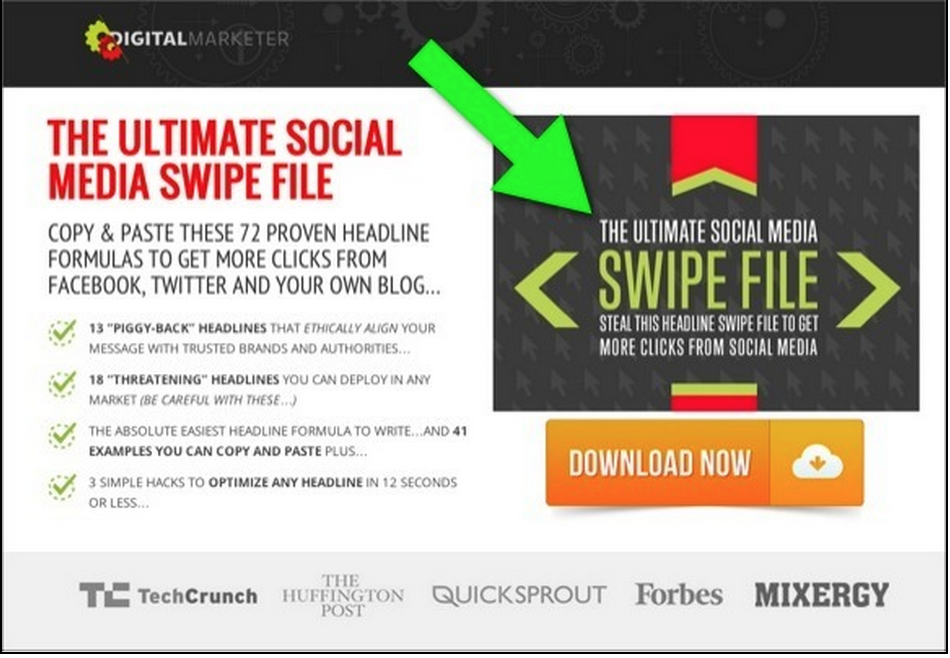
[Image Source: Digital Marketer, https://optinmonster.com/wp-content/uploads/2015/10/Screen-Shot-2015-10-07-at-5.24.06-PM.png ]
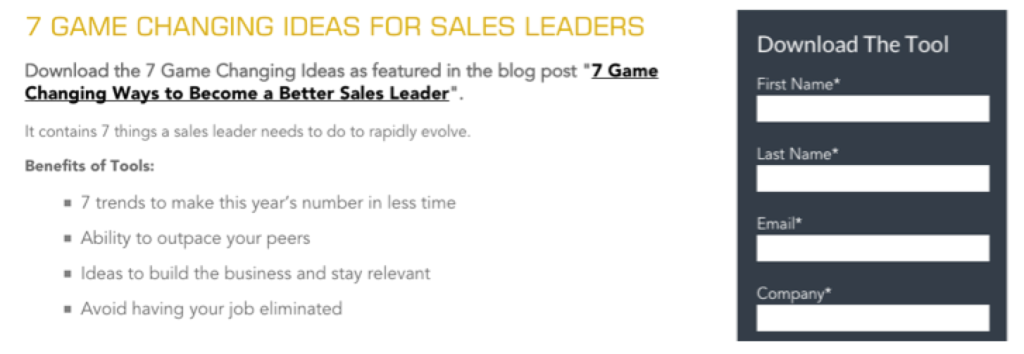
[Image Source: Sales Benchmark Index, https://optinmonster.com/wp-content/uploads/2015/10/Screen-Shot-2015-10-07-at-5.26.31-PM1-1024×354.png ]
These are all very effective, as you want to get the immediate benefits across to your customers.
They’ll be receiving value in return for their subscription, and the more concise you can be (without missing any important details), the better.
Designing the Lead Magnet Opt-In
It’s also important to visually stimulate the customers to make the offer even more enticing. You’ll notice that most lead magnet pages contain images and bulleted lists. The focus is on brevity and capturing the leads’ attention.
Additionally, you can also offer social proof and testimonials to warm up your leads even more.
The wording is also very important when it comes to creating your lead magnet.
You can:
- Promise tangible results (losing 20 pounds)
- Create a sense of urgency (time-limited offer)
- Use fear of missing out (statistics showing how much the lead is missing out on)
- Showing the value of the lead magnet (leads receiving $500’s worth for free)
- Setting a timeframe (the lead will see results immediately, within a week, within a month, etc.)
Data and Email Marketing
The next part of this step of creating your lead magnet is integrating it with email marketing software like ConvertKit or MailChimp. The customers should be able to enter their information, which will be stored to the subscriber list you select.
This opens up the possibility of you contacting them later on. And since we know that sales usually happen after the 7th contact, email marketing is a great way to do it as naturally as possible.
Be careful about asking too much information from your customers. Long opt-in processes result in a high drop-off rate, so keep it simple.
If you’re in the B2B space, it’s normal to ask for the company name, but if you’re dealing with B2C, just email and first name is enough. You can always ask for feedback and send out surveys later on, at which point your leads will have developed trust in you.
While these opt-in processes are perfect for landing pages that customers will be directed to through ads, you should also consider offering your lead magnets when the customer navigates organically to your business’ website.
Step 4: Integrating Your Lead Magnet with Existing Offer
This is typically the part of lead magnet creation where pop-ups come in.
Pop-ups are a great way to make website visitors notice your lead magnet, but you should approach them carefully.
Fortunately, pop-up builders and email integrations today offer a variety of options for the placement of pop-ups, such as:
- Pop-up appears when the visitor wants to close your website
- Pop-up appears when the visitor has been on your website for a certain amount of time
- Pop-up appears when the visitor has scrolled down 50% of your website
You also have the option of the pop-up appearing as soon as your potential lead visits your website, although we discourage you from choosing that option as it may seem too pushy due to the fact that you haven’t demonstrated any kind of value to the lead yet.
A great example of an attention-catching pop-up is the one that Jeff Bullas uses to notify website visitors of his free eBook:

[Image Source: JeffBullas.com]
Even though it’s a full-screen pop-up, it appears only when the visitor wants to close the tab so Bullas isn’t losing out by people not realizing that he even has a lead magnet.
Pay attention to his choice of words, as well. He promises to help his leads double their traffic, which is one of the methods of wording lead magnet offers to increase subscriptions.
Step 5: Promoting and Advertising Your Lead Magnet
If you’ve created a great lead magnet, you want people to see it. After all, it is the best method to draw in new leads and convert them to customers.
When it comes to lead magnet promotion, you should treat the magnet as a separate product. This means you can use standard promotion methods such as:
- Organic traffic (SEO)
- Referrals
- Social media (Facebook, Twitter, LinkedIn, Reddit)
- Employee advocacy (made easier through DrumUp)
- Paid advertising
Again, the promotion method you select will depend on the type of lead magnet you’ve created.
For example, Twitter would respond best to quizzes, while LinkedIn users appreciate white papers and eBooks. Another great social network to use is Reddit, as it helps you with audience segmentation and targeting.
Save time managing your social media accounts
Are you still managing your social media accounts directly from Facebook/Twitter/LinkedIn? Make your life easier by managing all your social media in one place, schedule posts, repeat posts, curate content and more. Try DrumUp now, it's free, forever.
Best Practices for Lead Magnet Promotion Creative
1. Emphasize usefulness & action. Make sure you show your lead magnet’s value to leads.
For example, LinkedIn has recently run a Facebook ad, offering a free eBook on the buyer’s journey.
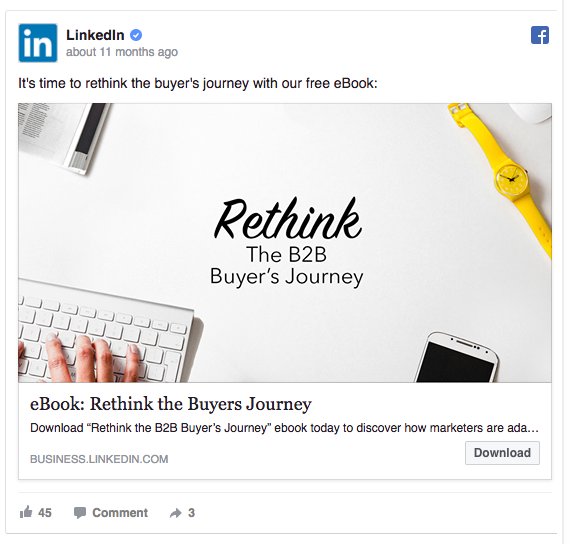
[LinkedIn.com / Image source: https://infusionweb-res.cloudinary.com/image/upload/v1523655650/linkedin_cta_facebook_lheyc0.png ]
Facebook lead magnet ads are also very useful, as they come with CTA buttons such as LinkedIn’s “Download.”
2. Make the copy short & sweet. Emphasize usefulness with copy, and don’t explain too much. Instead, explain (or tease) the benefits in one or two sentences. If you can start with a question or a statistic, that’s even more interesting for the leads.
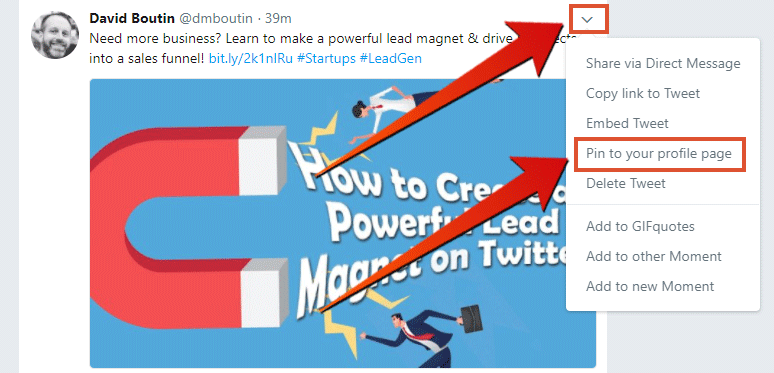
[David Boutin / Image source: https://i1.wp.com/maximizesocialbusiness.com/wp-content/uploads/2017/12/pin-a-tweet.png?resize=774%2C373&ssl=1 ]
David Boutin here advertises making lead magnets on Twitter and shows exactly how to write great lead magnet copy. It starts with a question and tells leads exactly what they’ll learn if they click on the link.
When writing copy, choose actionable words such as make, learn, do, create, drive. These automatically encourage the leads to take action and get your lead magnet, and they’re especially important as a part of the CTA (call to action).
3. Visibility. Depending on the platform and format you choose for your lead magnet promotion, make sure that it stands out from the users’ regular feeds. You don’t want to be lost in the sea of content.
For example, Asana’s ad is very effective:
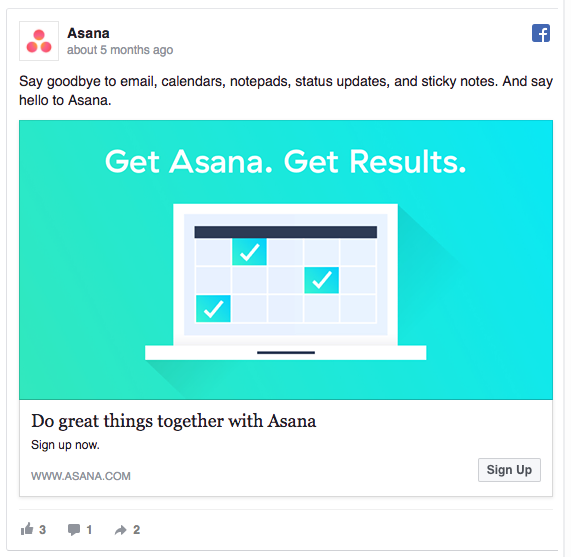
[Asana.com / IMAGE SOURCE: https://infusionweb-res.cloudinary.com/image/upload/v1523655650/asana_facebook_ad_okswfp.png ]
It not only has a short and clear copy, and an actionable CTA, but it’s also highly visible on the standard blue-and-white Facebook feed.
Step 6: Measuring Your Results
After you’ve successfully created and launched your lead magnet, it’s time to see what kind of results you’re getting.
Hopefully, you’ll notice it by the number of calls and emails, but it’s good to monitor metrics such as drop-off points and click-through rates (in comparison with conversion rates) just to assess the health of your lead magnet.
The easiest way of doing this is by integrating Google Analytics with your website.
Finally, we recommend testing your lead magnets until you’ve found the perfect offer. Sometimes you may find that you haven’t explained your offer clear enough, or that there’s a lead magnet that would work better with your audience.
However, no matter what you do, remember that lead magnets as a part of the content marketing strategy mean providing value.
And while good design matters, nothing matters as much as approaching your audience and saying: I have something useful for you.
And it’s completely free.
[Image Source: Opt-in Monster / https://optinmonster.com/wp-content/uploads/2015/10/12waysleadmagnet.png ]